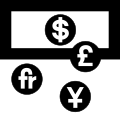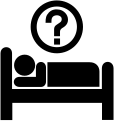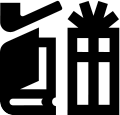
A pedestrian crossing is a place designated for pedestrians to cross a road, street or avenue. The term "pedestrian crossing" is also used in the Vienna and Geneva Conventions, both of which pertain to road signs and road traffic.
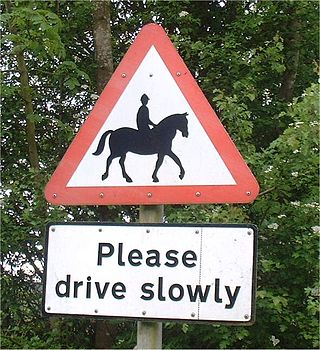
A pictogram is a graphical symbol that conveys meaning through its visual resemblance to a physical object. Pictograms are used in systems of writing and visual communication. A pictography is a writing system which uses pictograms. Some pictograms, such as hazard pictograms, may be elements of formal languages.

A warning sign is a type of sign which indicates a potential hazard, obstacle, or condition requiring special attention. Some are traffic signs that indicate hazards on roads that may not be readily apparent to a driver.

The general prohibition sign, also known informally as the no symbol, 'do not' sign, circle-backslash symbol, nay, interdictory circle, prohibited symbol, don't do it symbol, or universal no, is a red circle with a 45-degree diagonal line inside the circle from upper-left to lower-right. It is typically overlaid on a pictogram to warn that an activity is not permitted, or has accompanying text to describe what is prohibited.

A gender symbol is a pictogram or glyph used to represent sex and gender, for example in biology and medicine, in genealogy, or in the sociological fields of gender politics, LGBT subculture and identity politics.

Road signs in the United Kingdom and in its associated Crown dependencies and overseas territories conform broadly to European design norms, though a number of signs are unique: direction signs omit European route numbers and road signs generally use the Imperial System of units, unlike the rest of Europe. Signs in Wales and parts of Scotland are bilingual.

One-way traffic is traffic that moves in a single direction. A one-way street is a street either facilitating only one-way traffic, or designed to direct vehicles to move in one direction. One-way streets typically result in higher traffic flow as drivers may avoid encountering oncoming traffic or turns through oncoming traffic. Residents may dislike one-way streets due to the circuitous route required to get to a specific destination, and the potential for higher speeds adversely affecting pedestrian safety. Some studies even challenge the original motivation for one-way streets, in that the circuitous routes negate the claimed higher speeds.

Bag tags, also known as baggage tags, baggage checks or luggage tickets, have traditionally been used by bus, train, and airline carriers to route checked luggage to its final destination. The passenger stub is typically handed to the passenger or attached to the ticket envelope:
- to aid the passenger in identifying their bag among similar bags at the destination baggage carousel;
- as proof—still requested at a few airports—that the passenger is not removing someone else's bag from the baggage reclaim hall; and
- as a means for the passenger and carrier to identify and trace a specific bag that has gone astray and was not delivered at the destination. The carriers' liability is restricted to published tariffs and international agreements.

ISO 7001 is a standard published by the International Organization for Standardization that defines a set of pictograms and symbols for public information. The latest version, ISO 7001:2023, was published in February 2023.

Road signs in Sweden are regulated in Vägmärkesförordningen, VMF (2007:90), and are to be placed 2 metres from the road with the sign 1.6 m from the base for motorized roads. Except for route numbers, there are a maximum of three signs on a pole, with the most important sign at the top. All signs have a reflective layer added on selected parts of the sign as is custom in European countries; most larger signs also have their own illumination.

Road signs in Malaysia are standardised road signs similar to those used in Europe but with certain distinctions. Until the early 1980s, Malaysia closely practice in road sign design, with diamond-shaped warning signs and circular restrictive signs to regulate traffic. Signs usually use the Transport Heavy font on non-tolled roads and highways. Tolled expressways signs use a font specially designed for the Malaysian Highway Authority (LLM) which is LLM Lettering. It has two type of typefaces, LLM Narrow and LLM Normal. Older road signs used the FHWA Series fonts typeface also used in the United States, Canada, and Australia.

Road signs in Thailand are standardized road signs similar to those used in other nations but much of it resembles road signage systems used in South American countries with certain differences, such as using a blue circle instead of a red-bordered white circle to indicate mandatory actions. Until the early 1980s, Thailand closely followed American, European, Australian, and Japanese practices in road sign design, with diamond-shaped warning signs and circular restrictive signs to regulate traffic. The Department of Railway maintains a standard on the typeface used in the sign, with custom made type for Thai text, unofficially named “Thang Luang”(อักษรทางหลวง) and a small derivation of FHWA Series fonts typeface, which is used on American road signage, for Latin text. In most Bangkok Metropolitan Area's routes, TS Lopburi is still used.

Road signs in South Korea are regulated by the Korean Road Traffic Authority.

Road signs in Finland were formerly regulated in Tieliikenneasetus (5.3.1982/182), but now are currently regulated in Siirtymäsäännökset (8.5.2020/360).

Road signs in Greece are regulated by the Ministry of Transport and the Hellenic Traffic Police, according to the Greek Highway Code.

Road signs in Mauritius are standardised traffic signs used in Mauritius according to the Traffic Signs Regulations 1990. They are heavily modelled on road signs in the United Kingdom, since Mauritius is a former British colony. Mauritius drives on the left.

Road signs in Hong Kong are standardised by the Transport Department. Due to being a former British territory, the road signage in Hong Kong is similar to road signs in the United Kingdom, with the addition of Traditional Chinese characters.
Road signs in Canada may conform to the Manual of Uniform Traffic Control Devices for Canada (MUTCDC) by the Transportation Association of Canada (TAC) for use by Canadian jurisdictions. Although it serves a similar role to the MUTCD from the US Federal Highway Administration, it has been independently developed and has a number of key differences with its American counterpart, most notably the inclusion of bilingual (English/French) signage for jurisdictions such as New Brunswick with significant anglophone and francophone population, and a heavier reliance on symbols rather than text legends.

Road signs in Sri Lanka are standardized to closely follow those used in Europe with certain distinctions, and a number of changes have introduced road signs that suit as per local road and system. Sri Lankan government announced by a gazette that aimed to get a facelift and introduction of over 100 new road traffic signs. The new change will be replaced in colour and sizes and introduction of Variable-message sign & electronic digital sign boards in express highways. The Japanese government has granted LKR 1.24 billion to implement message signs in expressways.
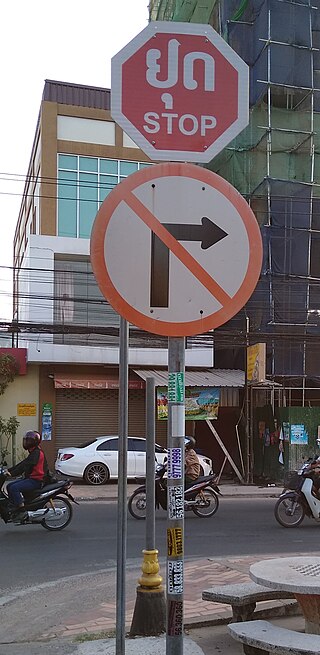
Road signs in Laos generally follow those used in most European countries as set out in the Vienna Convention on Road Signs and Signals. Despite this, the country itself has never signed the Vienna Convention on Road Signs and Signal. Inscriptions on traffic signs are in Lao, the national language of Laos. However, English is also used for stop and important public places such as tourist attractions, airports, railway stations, and immigration checkpoints. Both Lao and English are used on directional signage.


